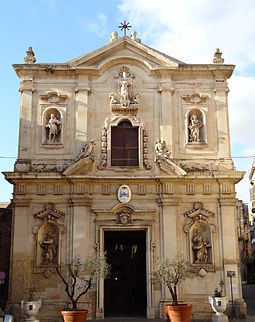
The Archdiocese of Capua is a Latin diocese of the Catholic Church in Capua, in Campania, Italy, but its archbishop no longer holds metropolitan rank and has no ecclesiastical province. Since 1979, it is a suffragan of the Archdiocese of Napoli, i.e. no longer has its own ecclesiastical province nor metropolitan status.

The Archdiocese of Otranto is a Latin archdiocese of the Catholic Church in Italy. The seat of the diocese is at Otranto Cathedral in the city of Otranto, Apulia. It is a suffragan of the archdiocese of Lecce.
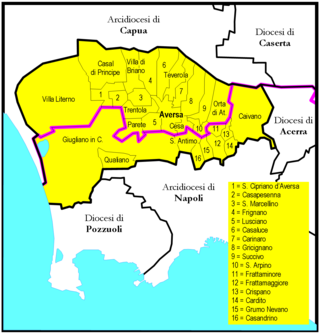
The Diocese of Aversa is a Latin diocese of the Catholic Church in Campania, southern Italy, created in 1053. It is situated in the Terra di Lavoro (Liburia), seven miles north of Naples, and eight miles south of Capua. It is suffragan of the Archdiocese of Naples.

The Archdiocese of Reggio Calabria-Bova is a Latin Church ecclesiastical territory or diocese of the Catholic Church in Calabria, southern Italy. It received its current title in 1986, when the independent Diocese of Bova was suppressed, and the territory and title of the diocese added to that of the Archdiocese of Reggio.

The Diocese of Cassano all'Jonio is a Latin diocese of the Catholic Church in Calabria.

The Archdiocese of Lecce is a Latin Church ecclesiastical territory or archdiocese of the Catholic Church in Apulia, southern Italy. The diocese has existed since the 11th century. On 28 September 1960, in the bull Cum a nobis, Pope John XXIII separated the diocese of Lecce from the ecclesiastical province of Otranto and made it directly subject to the Holy See. In the bull Conferentia Episcopalis Apuliae issued on 20 October 1980, Pope John Paul II created the ecclesiastical province of Lecce, with the Archdiocese of Otranto becoming a suffragan diocese.

The Archdiocese of Crotone-Santa Severina is a Latin Church diocese of the Catholic Church in Calabria in southern Italy, created in 1986 when it was combined with the Diocese of Santa Severina. It is now a suffragan of the Archdiocese of Catanzaro-Squillace. In 2013 there was one priest for every 1,841 Catholics.

The Archdiocese of Trani-Barletta-Bisceglie is a Latin Church ecclesiastical territory or archdiocese of the Catholic Church in Italy in the province of Barletta-Andria-Trani in Apulia. Formerly a metropolitan see, in 1980 it became a suffragan archdiocese in the ecclesiastical province of the metropolitan Archdiocese of Bari-Bitonto. It received its current name in 1986, when the Archdiocese of Trani added to its title the names of two suppressed dioceses merged into it.
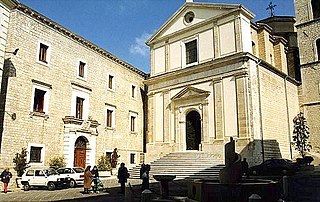
The Archdiocese of Potenza-Muro Lucano-Marsico Nuovo is a Latin diocese of the Catholic Church in Basilicata, southern Italy, created in 1986. In that year the Diocese of Muro Lucano was united into the Archdiocese of Potenza e Marsico Nuovo, which had been elevated to an archdiocese in 1973, and made a metropolitan see in 1976. The historical Diocese of Potenza was united with the Diocese of Marsico Nuovo in 1818.

The Diocese of Conversano-Monopoli is a Latin diocese of the Catholic Church in Apulia. It has existed since 1986, when the diocese of Monopoli was united with the historic diocese of Conversano. The diocese is a suffragan of the Archdiocese of Bari-Bitonto.

The Diocese of Caserta is a Latin diocese of the Catholic Church in Campania, southern Italy. It is a suffragan of the Archdiocese of Naples. In 1818 Pope Pius VII united this see with the diocese of Caiazzo, but Pope Pius IX made them separate sees. In 2013 in the diocese of Caserta there was one priest for every 1,703 Catholics; in 2016, there was one priest for every 2,008 Catholics. The diocesan Major Seminary currently (2019) has four seminarians.
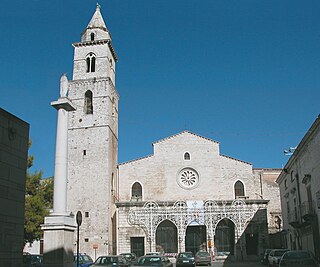
The Diocese of Andria is a Latin diocese of the Catholic Church in Apulia, seated at Andria Cathedral which is built over a church dedicated to St. Peter, about ten miles southwest of Trani. It is a suffragan of the archdiocese of Bari-Bitonto. The diocese has 39 parishes, with one priest for every 1,573 Catholics.

The Diocese of Sessa Aurunca is a Latin diocese of the Catholic Church in southern Italy. Since 1979 it has been a suffragan of the Archdiocese of Naples.

The Diocese of Castellaneta is a Latin diocese of the Catholic Church in Apulia. It is a suffragan of the Roman Catholic Archdiocese of Taranto.

The Archdiocese of Catanzaro-Squillace is a Latin Church diocese of the Catholic Church in Calabria, has existed in its current form since 1986. In that year the Archdiocese of Catanzaro became a metropolitan see, and was combined with the diocese of Squillace.
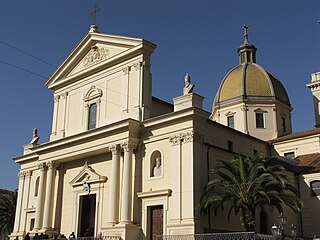
The Diocese of Lamezia Terme is a Latin Church diocese of the Catholic Church in Calabria. In 1818 the ancient see of Martirano, the former Mamertum, was united to the diocese of Nicastro. The diocese was then a suffragan of the archdiocese of Reggio in Calabria. In 1986, the historic Diocese of Nicastro had its name changed. It is currently called the Diocese of Lamezia Terme, and it is a suffragan of the Archdiocese of Catanzaro-Squillace. The name change reflects the incorporation of the comune of Nicastro into Lamezia Terme, an administrative change of 1968 on the part of the State of Italy.

The Diocese of Tursi-Lagonegro is a Latin diocese of the Catholic Church in Basilicata, southern Italy. It is a suffragan of the Archdiocese of Potenza-Muro Lucano-Marsico Nuovo.
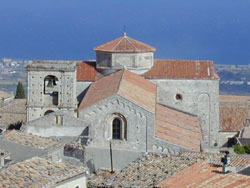
The Diocese of Locri-Gerace is a Latin diocese of the Catholic Church in Calabria. It is a suffragan of the Archdiocese of Reggio Calabria-Bova.
The Italian Catholic diocese of Lacedonia, a suffragan of the archdiocese of Benevento in Campania, existed until 1986 when incorporated into the reorganized Roman Catholic Diocese of Ariano Irpino-Lacedonia.
The Diocese of Martirano was a Roman Catholic diocese located in the village and comune of Martirano in the province of Catanzaro in the Calabria region of Italy. It was suppressed in 1818 to the Diocese of Nicastro.
